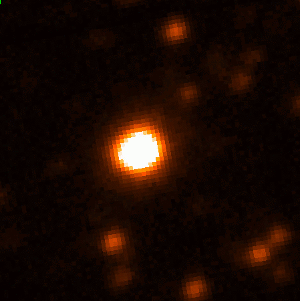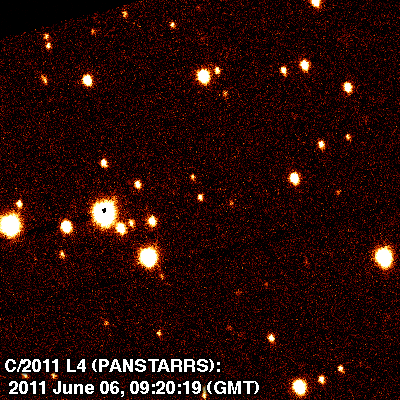Searching for Clues in the Outer Solar System
June 24th, 2011 by darinragozzineThe history of the solar system deserves investigation because it provides the astronomical backstory for our civilization and suggests processes that might be at work around other stars that could form their own planetary systems. With just the 8 major planets, it would be difficult or impossible to get much information on how everything came to be. The additional insights provided by the properties of small bodies, leftovers of planet formation, provide valuable clues to the processes active in solar system history. For example, Pluto and other objects now known in similar orbits show strong evidence that the outer planets, particularly Neptune, have moved substantially from where they originally formed. A well-characterized survey of the wonderful icy bodies that orbit beyond Jupiter will continue to refine these theories in useful ways.
There is no question that Pan-STARRS 1 (PS1) is a unique telescope that can provide unique results. There have been other surveys of the sky, but none have the deep, complete, multi-color, multi-epoch observations of PS1. Such a telescope and survey allow for a wealth of new investigations in a variety of different fields, including those relevant to the history of the solar system.
The organization of the PS1 Science Consortium has been focused on 12 Key Projects, ranging from the inner solar system to distant galaxies. The Outer Solar System Key Project (PS1OSS) is led by my advisor, Matt Holman at the Harvard-Smithsonian Center for Astrophysics. We’re interested in the small body populations beyond the orbit of Jupiter, including the Kuiper belt and its citizens (like Pluto) and to the farthest reaches of our solar system. Similar searches have been undertaken before but since small bodies are only visible by reflected sunlight (and even though these faraway bodies are much larger than asteroids) they are so faint that only recent astronomical surveys have been the first to really understand what’s out there.
The outer solar system hosts a variety of interesting icy bodies with a range of sizes. PS1 will be sensitive to objects as small as tens of kilometers miles in diameter for the closest objects up to Jupiter-sized objects (if there are any) well beyond the edge of the known population at about 100 times the distance from the Sun to the Earth (i.e., 100 AU). These objects are usually classified by the way they orbit the Sun: Centaurs are in chaotic orbits pushed around by the giant planets (and will become comets), Trojans are in stable orbits that lead or trail the giant planets, and Kuiper belt objects (KBOs or Trans-Neptunian Objects or TNOs) are in mostly stable orbits beyond Neptune. There are also objects in very distant orbits like Sedna; we don’t know how they got there, but finding more of them will teach us something interesting about how the solar system formed.
The vast majority of solar system objects are too small to appear different from a single point of light, even for the best telescopes in the world. How will PS1 distinguish a solar system object from every other point of light out there? The Greeks knew that some stars didn’t stay in fixed relative locations and these wandering stars were called “planetes” from the Greek word for wanderer. In a combination of the motion of the Earth and the motion of the small body, these objects move relative to the fixed background of stars.
My favorite illustration of the first effect, known as parallax, is to stick out your arm with your thumb up and to close one eye and then the other. Your thumb appears to move relative to the background. Bringing your thumb closer causes larger apparent motion. In the same way, the motion of the Earth in its orbit provides different vantage points which are like looking through one eye and then the other and objects in our solar system move appreciably compared to the more plentiful stars.
This image shows this effect on Pluto as observed by PS1 and how it changes position in a 15 minute interval, due to parallax.
Both the inner and outer solar system key projects of PS1 look for moving points of light to identify solar system objects. This is more challenging than it might seem at first glance, especially if you imagine a crowded field of stars. The sheer amount of PS1 data makes it impossible to imagine a human-eye search, so automated routines have been developed to find these objects. The inner solar system team uses the Moving Objects Processing System or MOPS, but a more specific algorithm can be used in the outer solar system since these objects move much more slowly (mostly because they are more distant, but also because their orbital motion around the Sun is slower in accordance with Kepler’s Third Law). To really identify an object and understand its motion around the Sun, it has to be identified by its motion, usually during one night, and then a giant and complex connect-the-dots algorithm is employed to eliminate false positives and track the motion of real solar systems objects over weeks and months and years.
Now, the PS1OSS survey is not the first survey of the Kuiper belt. Other surveys have been done, but PS1OSS has some advantages that other surveys do not. With a location in Maui, PS1 can see both North and South of the Earth’s orbit, covering virtually the entire region where solar system objects appear on the sky. The multi-epoch observations by PS1 allow us to track the orbits properly. (Some past surveys did not have the giant field of view that we have and so lost some objects; we will find these and link their orbits together using data from both surveys.) One aspect I’m really excited about is the precise color observations that PS1 obtains… by using different filters (glass screens that only allow certain colors to pass through), we’ll be able to identify the color of many outer solar system objects. This has been done for small groups of objects, but the comprehensive and precise color survey of PS1 will be new and exciting.
Finally, the all-sky nature of the survey will ensure that we didn’t miss anything significant. Past surveys have not been as complete as PS1 will be. The best example of a near-complete outer solar system survey is that of Mike Brown at Caltech (my former advisor) who discovered dwarf planets Eris (the object larger than Pluto), Haumea, and Makemake and other interesting objects like Sedna. Mike’s survey covered most of the sky, but there’s still a good chance that 1-3 dwarf planets were missed and that we’ll be the first to catch these intriguing worlds. We may also find another Sedna-like object, which would be a true boon to interpreting how the planets formed. And we’ll have a well-characterized survey that can help us take an accurate census of just what is out there.
The PS1OSS Key Project is hard at work identifying objects, determining their orbits, measuring colors, and generally putting together the full picture of the outer solar system. The orbits and distribution of these small bodies are the fingerprint of processes at work in the history of our solar system. We’re all looking forward to the results of the unique PS1 survey in our interpretation of that history.




